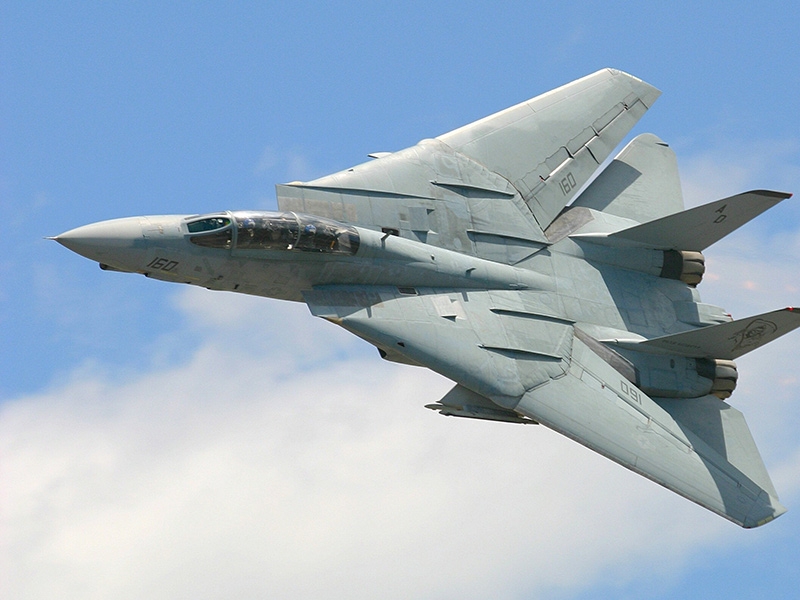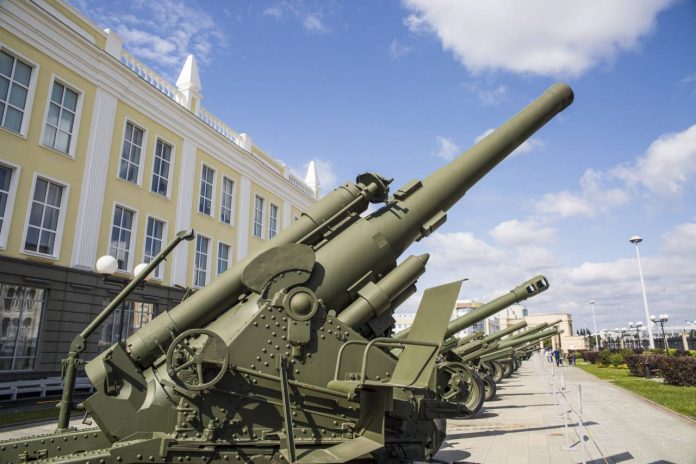
To start this article, we decided to not quite traditionally. Just because, it considered it appropriate to talk about one of the lesser-known episodes of the war on the Karelian Isthmus. By virtue of, probably, the lack of a more or less climactic battle in the area, we have very little say about the Karelian Front. so, the story of the Captain Ivan Vedemenko, in future — Hero of the Soviet Union.
Vedemenko captain commanded a battery «Karelian sculptors». This name as early as during the Soviet-Finnish war received 203 mm howitzer special power B-4. We received a well-deserved. These howitzers perfectly «dismantled for spare parts» Finnish pillboxes. the, that remained after firing heavy ammunition bunkers looked really bizarre. Chunks of concrete from sticking out in all directions fittings. So that, soldier's name howitzer well-deserved and honorable.
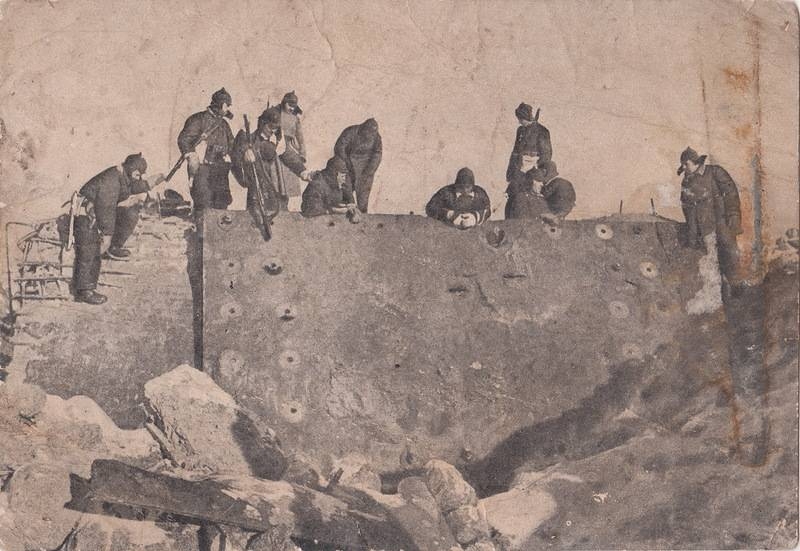
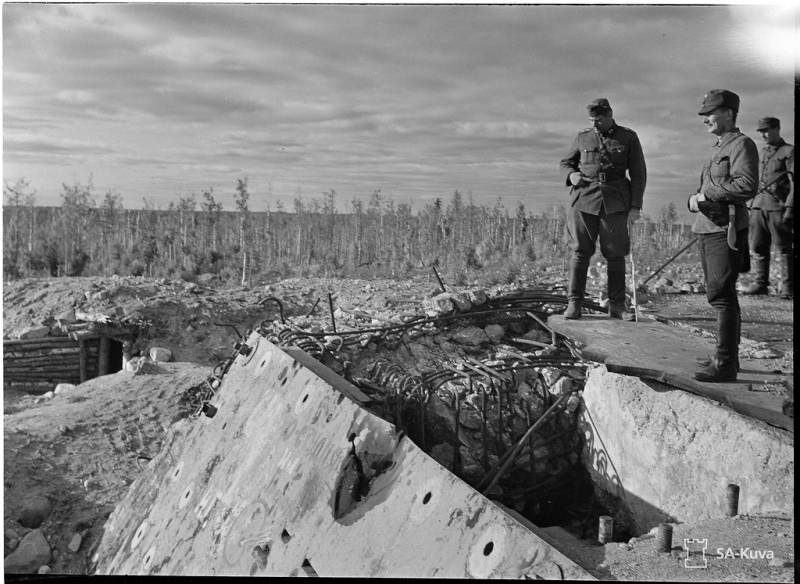
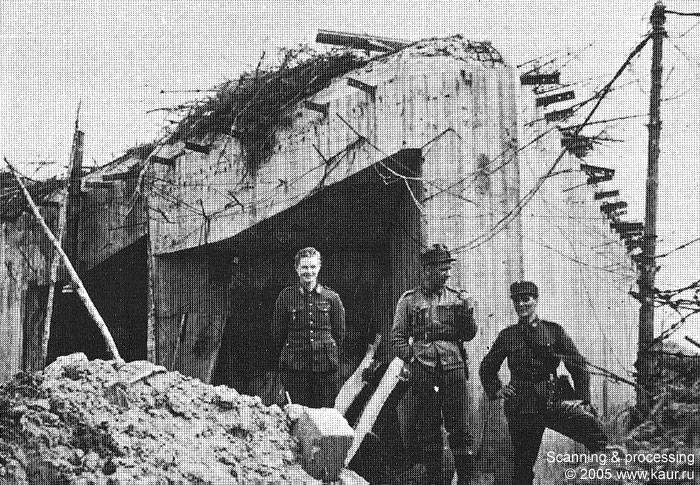
But we will focus on a different time. on June 1944 of the year. It was at this time, our army launched an offensive on the Karelian Isthmus. During the offensive assault team entered the Finnish impregnable bunker «Millionaire». Inaccessible in the literal sense of the word. The thickness of the walls of the bunker was so, that destroy it, even with heavy aviation bombs it was not really — 2 meters of reinforced concrete!
The walls of the bunker on the left in the ground 3 floors. The top of the bunker, except concrete, protected armored cupola. The wings were covered bunkers smaller. DOT was built as the main area of defense unit. 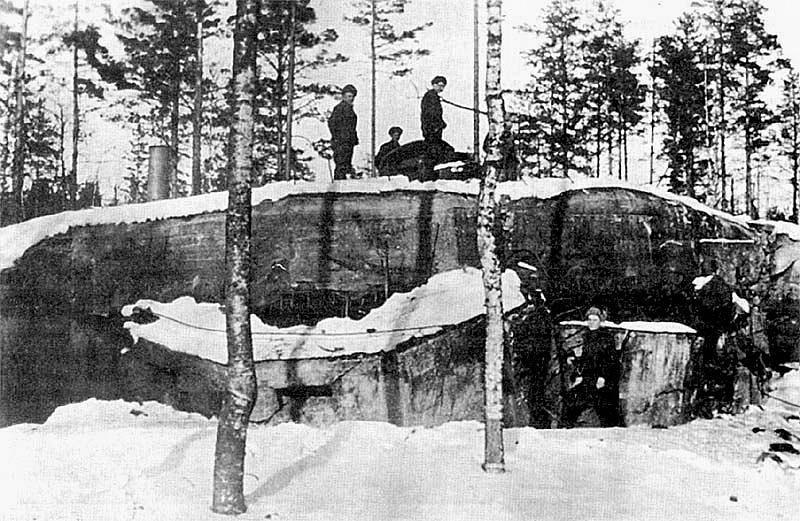
To help assault team Nicholas Bogaeva (group commander) Battery captain came Vedemenko. Two howitzer B-4 are arranged in 12 km from the bunker to the closed position.
Commanders have positioned your NP a short distance from the bunker. Almost a minefield (DOT was surrounded by several rows of minefields and barbed wire). The morning. Combat Vedemenko began sighting.
The first shells tore embankment bunker, exposing the concrete wall. The second shell ricocheted off the wall. The third corner hit the bunker. That was enough for, to the battalion commander I made the necessary adjustments and started firing facilities. by the way, it is worth noting one thing.
The proximity of the NP is not only made it possible to adjust each shot battery commander, but also to ensure «unforgettable experience» for all, who was on NP. Shells weighing 100 kg, with an appropriate roar, flew to the pillbox at low altitude over our commanders and soldiers.
So to speak, Event participants can understand their own experience, what have «direct support of heavy artillery».
Break through the wall was only about 30 meters projectile. The binoculars were visible reinforcement rods. All in all, it was used 140 shells, of which 136 We hit the target. «Karelian sculptors» They created their regular work, a «Millionaire» actually it turned into a monument of architecture.
And now go directly to the «architects» and «sculptors», special power howitzers B-4.
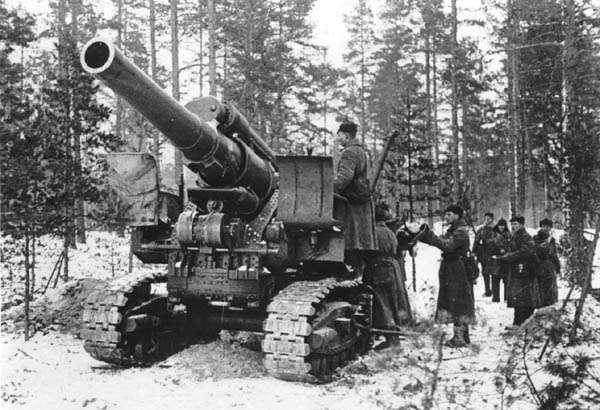
The story of these unique instruments should begin from afar. In November 1920 year at the Artillery Committee, which he was led by a former lieutenant general of the royal army, Robert Avgustovich Durlyaher, he's Rostislav Avgustovich Durlyahov, It was created Artillery Design Bureau under the leadership of Franz Linder Frantsevich. About this man we mentioned in a previous article.
In accordance with the decision of the Revolutionary Military Council of the USSR of rearming artillery large and extra power to the new domestic material part, KB Linder 11 December 1926 year given the task in the 46-month project to develop a 203-mm howitzer big reach. Naturally, project headed by the head of CB.
but, 14 September 1927 year F. F. Linder died. The project is transferred to the plant «Bolshevik» (previously Obukhov plant). Manage the project was entrusted to A. D. Gavrilov.
Designing howitzers was completed 16 January 1928 of the year. And, designers presented two projects. Ballistics body shells and in both embodiments were identical. The difference was the presence of the muzzle brake. In discussing the options, preference was given howitzer without muzzle brake.
The reason for this choice, as well as the choice of other high-powered guns, It became decover factor. Muzzle Brake created a cloud of dust, visible for kilometers. The enemy could easily detect the battery by means of aviation and even visual observation.
The first prototype howitzer B-4 was produced in the early 1931 of the year. It is a tool used to NIAP in July-August 1931 year during the shooting in order to select the charge to B-4.
After long polygon and military trials in 1933 by howitzer was adopted by the Red Army under the designation "203-mm howitzer sample 1931 of the year". Howitzer designed to destroy high-strength concrete, concrete and armored constructions, to combat large-lasting erections, or sheltered enemy artillery and long-range goals for the suppression.
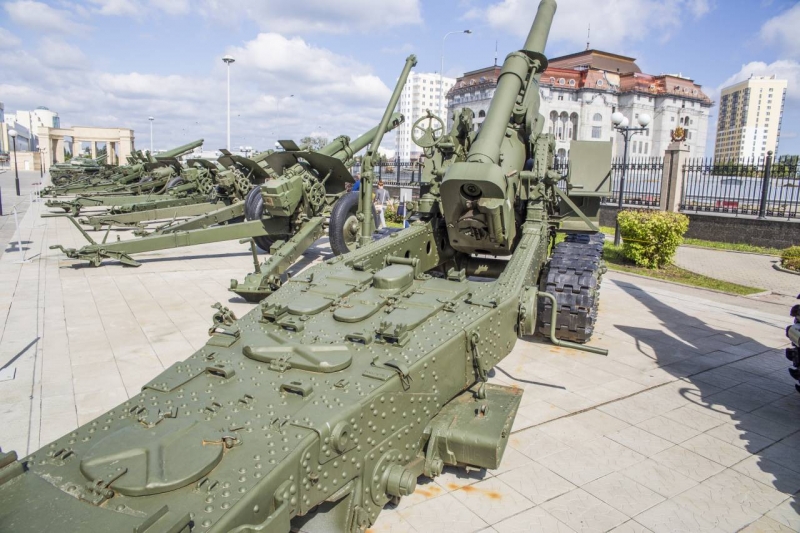
A special feature is the howitzer gun carriage to the track course. The successful design of the mast, howitzer provides a sufficiently high permeability and allows firing from the ground without the use of special machines, It became unified for the whole family of high-power tools. Using this unified mast allowed to accelerate the development and introduction of new instruments of great capacity.
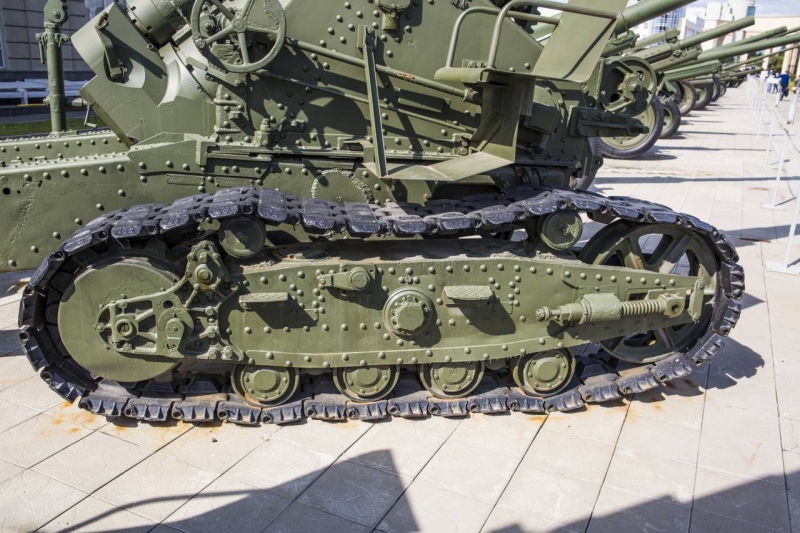
Upper mast machine howitzer B-4 was a riveted steel structure. Pin receptacle upper machine puts on the lower pin combat machine and rotated on it under the action of a turning mechanism. Provided at this firing sector was small and was only about ± 4 °.
For aiming guns in the horizontal plane at a greater angle needed to rotate in the appropriate direction all instrument. The lifting mechanism has a toothed sector. attached to the cradle. With the help of an instrument could inducing in a vertical plane over an angular range from 0 ° to + 60 °. To quickly bring the trunk to corner loading gun had a special mechanism.
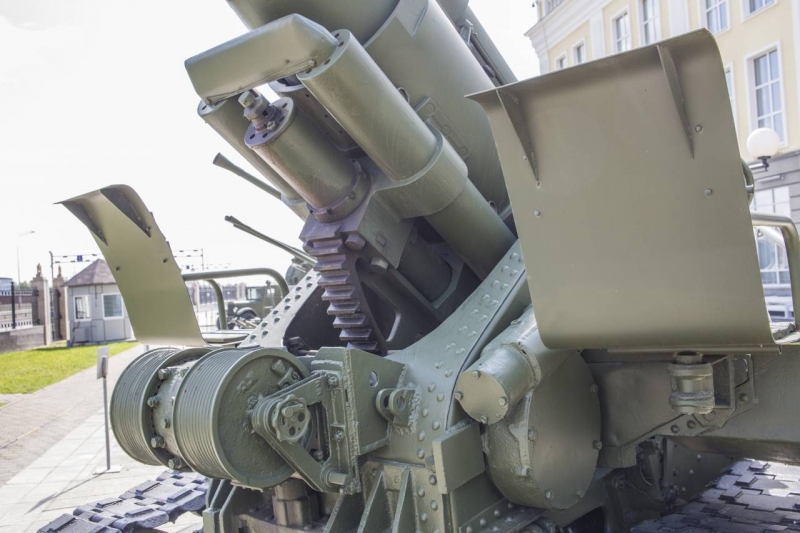
Device recoil system includes a hydraulic recoil buffer and recuperator hydropneumatic. All recoil device with reel remained motionless. Stability when shooting guns also provides opener, attached to the lower part of the machine Hobotova. In the front part of the bottom of the machine have been secured alloy clogs, in which the inserted axle combat. On the cone axis combat worn caterpillars.
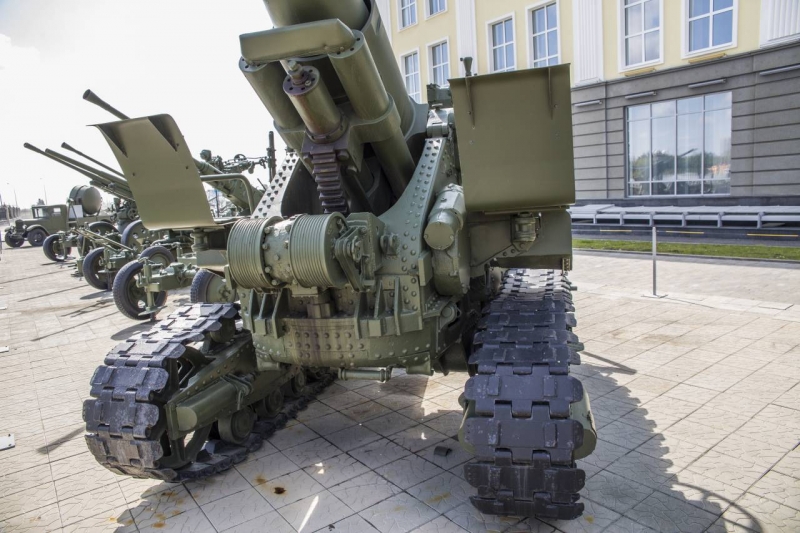
Howitzer B-4 had two types of trunks: bonded without liner and with liner, and-one-piece barrel with a liner. Replacing the liner could be made in the field. Regardless of the type of barrel length thereof was 25 calibres, the threaded portion of the length - 19,6 calibres. In the barrel were performed 64 rifling constant slope. The gate was a piston, used as a two-stroke, and trehtaktnye closures. Mass barrel with the shutter was 5200 kg.
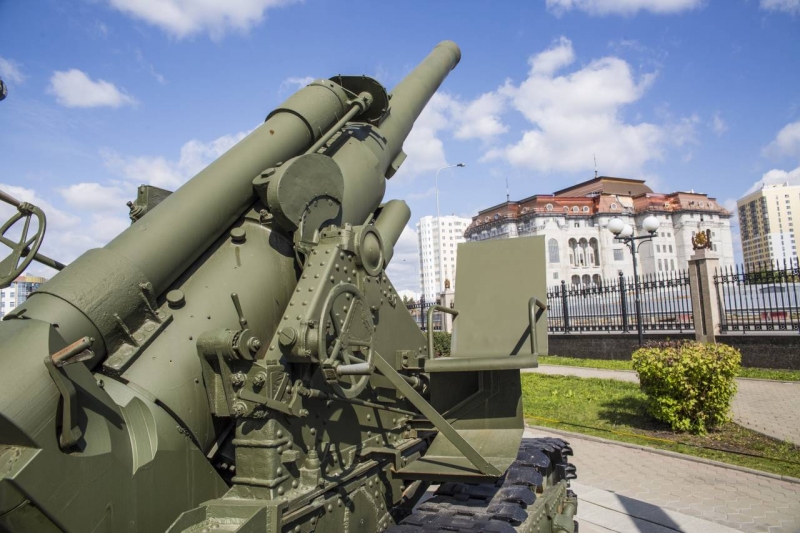
The howitzer can fire a variety of high-explosive shells and betonoboynymi, including shells, Shipped from UK to Russia during the First World War. It involves the use of a complete and 11 variable charges. Thus the total charge weight was 15,0-15,5 kg powder, 11 and the - 3,24 kg.
When firing projectiles total charge of P-625D, T-620 and T-620SH had initial velocity 607 m / s and provide targets defeat, remote at a distance 17 890 m. Due to the large angle of elevation (60 °) and variable charges, giving 12 different muzzle velocity, It shall be possible to choose the optimal trajectory to hit a variety of purposes. The loading was carried out by means of a manually operated crane. Rate of fire was 1 shot at 2 minutes.
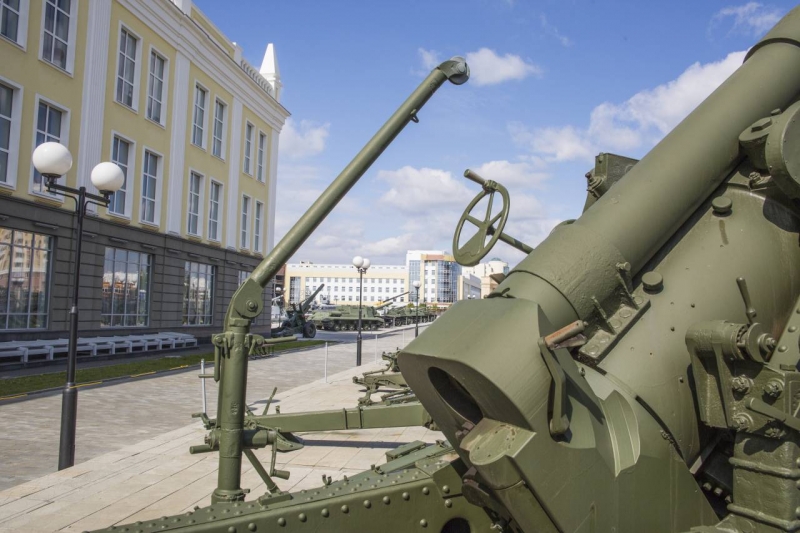
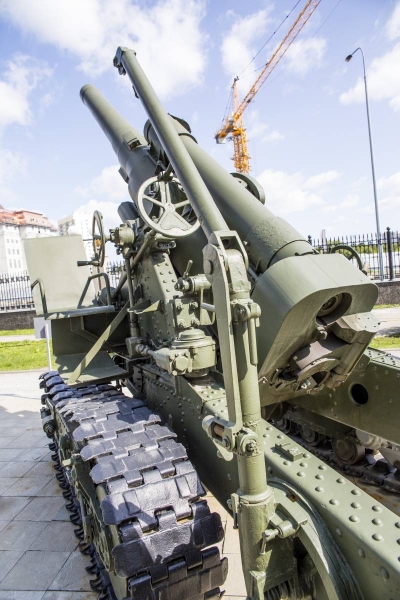
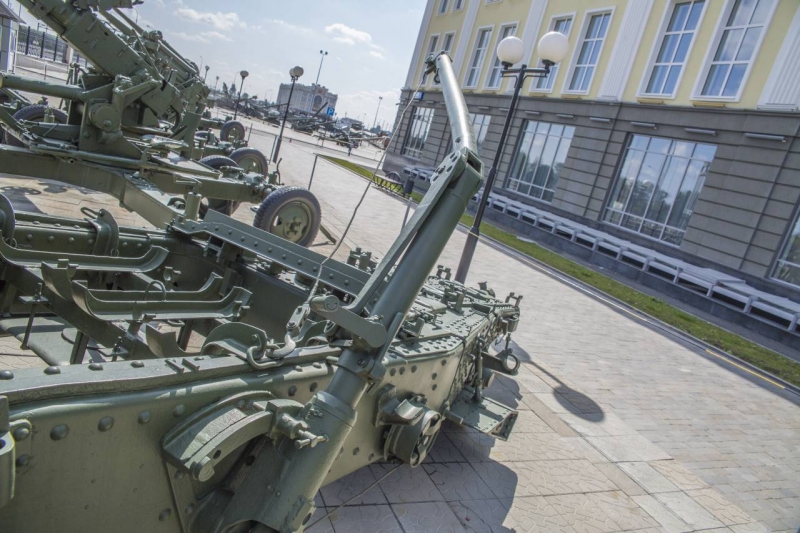
Dlya transportations howitzer razbiralasy two parts: trunk, shot with a gun carriage and laid on a special wagon, and connected with the front fascia tracked carriage - the carriage wagon. A short distance howitzer can be transported in the form of undismantled. (This mode of transportation is sometimes used in the fighting for the nomination of howitzers for direct fire on the enemy reinforced concrete defensive structures.)
For transportation of used crawler tractors of the "Kommunar", maximum permissible speed of movement on the road was 15 kmh. Wherein, caterpillar made it possible to increase the cross-guns on the road. Enough heavy guns easily overcome even wetlands area.
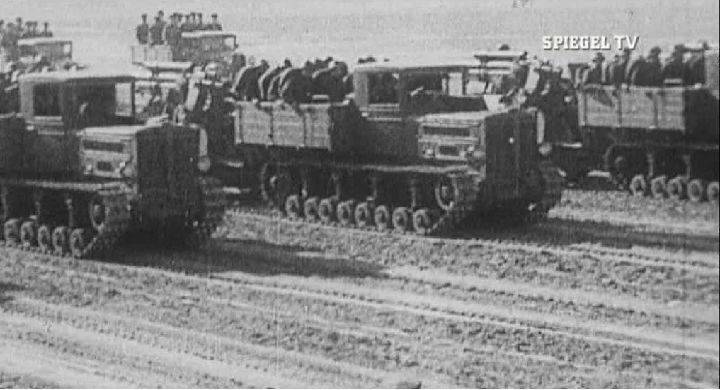
by the way, successful mast design has been used for other artillery systems. In particular, for intermediate samples 152mm guns Br-19 and 280-mm mortar Br-5.
Naturally, It raises the question of differences in the structure of howitzers. Why and how they were? The difference in the design of specific tools was evident. Wherein, it was howitzer B-4.
reasons, in our opinion, There were two. The first and main — small capacity Soviet factories, inability to implement projects. Simply put, plant equipment is not allowed to produce the required products. And the second reason — presence directly in the production of an entire galaxy of outstanding designers, which could adapt the project to the capabilities of a particular plant.
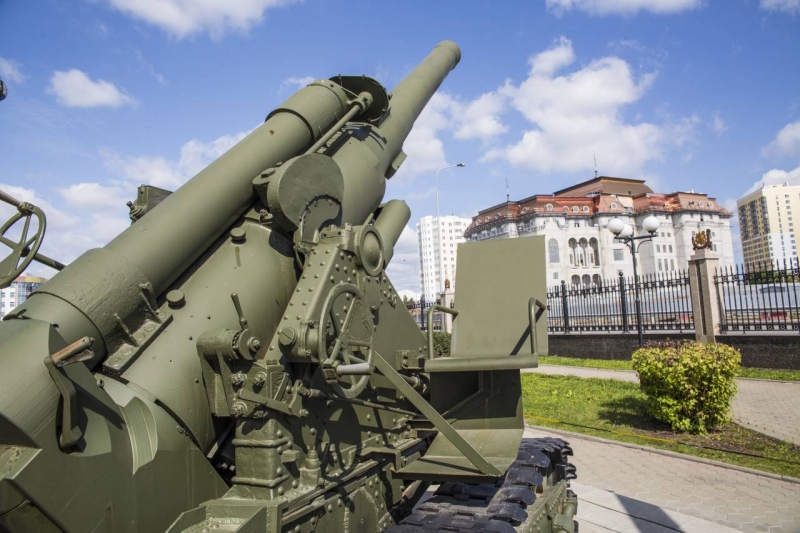
In the case of the B-4 was just so. Series production began in the factory of howitzers «Bolshevik» at 1932 year. In parallel, there was a task to start production and the plant «barricades». Both plants can not mass-produce howitzer according to the project. Local designer modified the projects under production capability.
«Bolshevik» He presented to the delivery of the first production howitzer in 1933 year. But pass it the state commission was unable to finish the year. «barricades» in the first half 1934 year released two howitzers. Then plant the last effort was able to release more 15 guns (1934 year). Production was halted. The only steel producer «Bolshevik».
constructors «Bolshevik» finalized howitzer. The new version has a more elongated trunk with improved ballistics. The new gun received a new index-B-4 BM (high-power). guns, issued before the modernization were called AB 4mm (low power). The difference between the BM and MM was 3 caliber (609 mm).
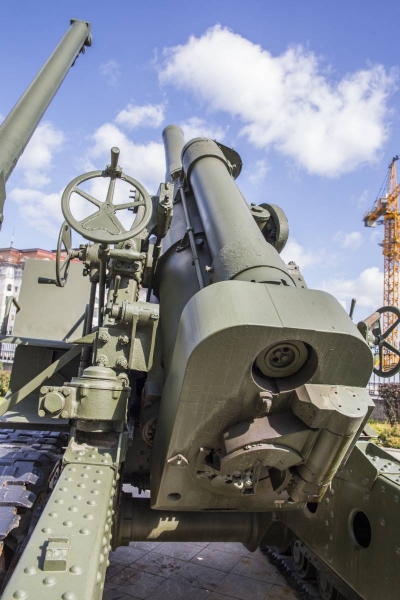
If you carefully consider the B-4 of these two plants, the sustainable impression, they are two different instruments. maybe, our opinion questionable, but the Red Army under the same designation received different howitzer. However, for the soldiers and officers of the artillery units it was not a big deal. The guns were the same for most indicators.
But also «Bolshevik» I could not boast of success in the production of B-4. AT 1937 year «barricades» again began collecting the howitzer. Furthermore, the production of drawn one more plant — Novokramatorsky. In this way, to the beginning of World War II production howitzers were deployed at three factories. A the total number of guns, which came in artillery units was 849 pcs (both modifications).
Baptism of fire howitzer B-4 obtained on the Soviet-Finnish front during the Winter War with Finland. On 1 Martha 1940 year, there was no 142 gaubitsы B-4. At the beginning of this article we mentioned the name of the soldier's gun. «Karelian sculptor». Lost or out of order for this war was 4 gaubitsы. Rate is more than decent.
Howitzer B-4 were only howitzer artillery regiments high power RVGK. In the state Regiment (from 19.02.1941 city) it had four divisions trehbatareynogo composition. Each battery consisted 2 gaubitsы. A howitzer was considered a platoon. All in the regiment had 24 gaubitsы, 112 tractor, 242 car. 12 motorcycles and 2304 personnel of the (of them 174 officer). TO 22.06.1941 g. There was a part of RVGK 33 regiments gaubitsami B-4. That is just across the state 792 gaubitsы.
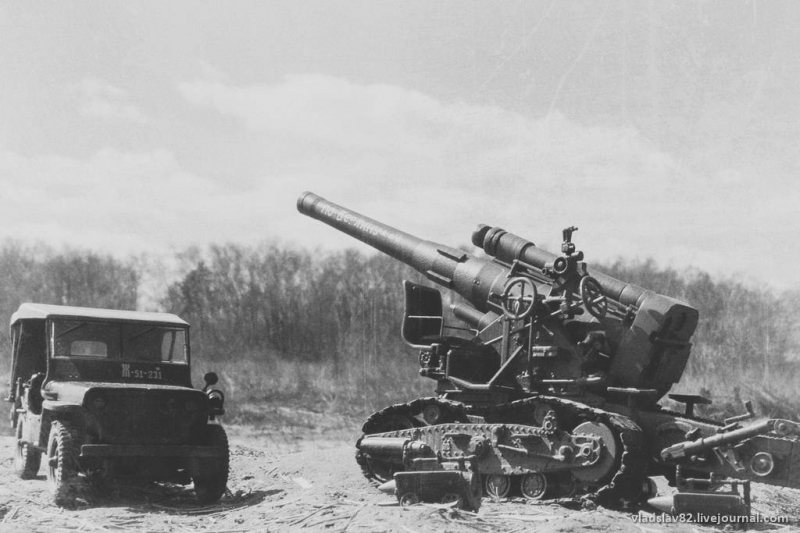
Great Patriotic B-4 began to actually only 1942 year. Although, in fairness, It should be noted, what in 1941 year we lost 75 howitzer. From those, that could not be sent to the eastern regions.
At the beginning of the war, several howitzers B-4 was captured by the Germans. So, in g. Dubno was captured by the Germans 529 th howitzer artillery regiment of high power. Due to lack of trucks, our troops were sent in good condition 27 203-mm howitzer B-4. Captured German howitzer received designation 20,3 see HaubiUe 503 (g). They were in service of several heavy artillery battalions GSC Wehrmacht.
Most of the guns during the war were destroyed, but according to German sources, even in 1944 year on the eastern front worked more 8 these tools.
Posses howitzer B-4 in 1941 it was possible to compensate for the increase in production. plants produced 105 guns! but, supply them to the front it had been suspended for failure to use during retreat. Red Army forces had been saving.
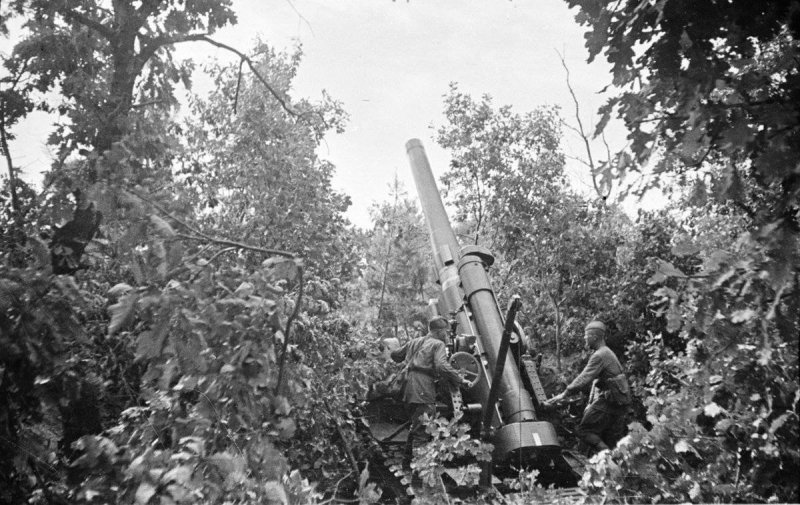
TO 1 May 1945 g. at 30 teams and 4 separate artillery regiments RVGK great power there 760 203-mm sample howitzers 1932 of the year.
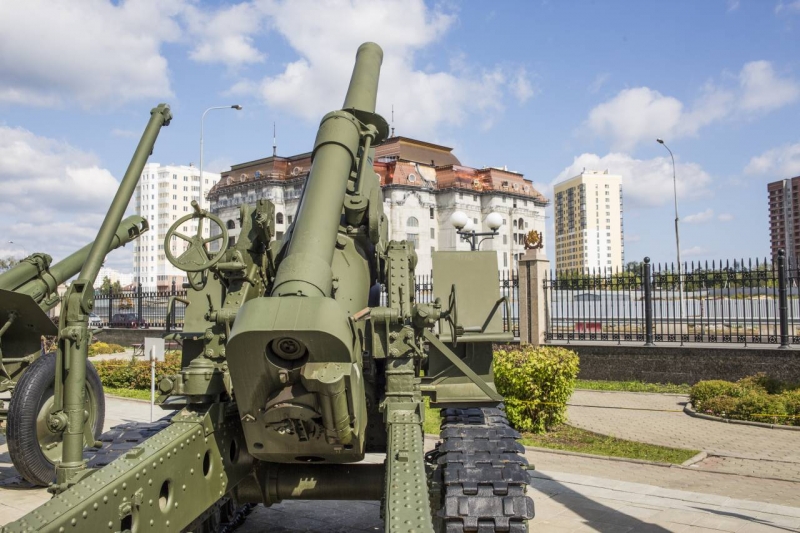
TTX heavy 203mm howitzer sample 1931 year B-4:
caliber - 203 mm;
Overall length - 5087 mm;
Weight - 17700 kg (in a combat-ready position);
The angle of vertical guidance - from 0 ° to + 60 °;
Angle traversing - 8 °;
The initial velocity of the projectile - 557(607) m / s;
Maximum range - 18025 m;
projectile mass - 100 kg.;
ammunition- 8 shots;
Calculation — 15 human.
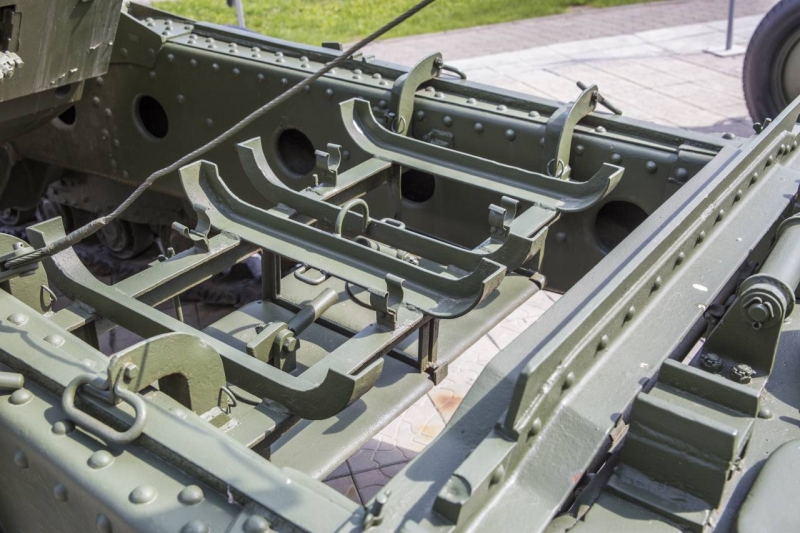 Trays on a gun carriage for shells
Trays on a gun carriage for shells
On the eve of the 75th anniversary of our victory at the Kursk Bulge, I want to tell you one more episode in the battle fighting the biography of the legendary Howitzer. Near the station Ponyri scouts found a German self-propelled gun «Ferdinand». Commander, it was decided to destroy a German artillery own.
However, power tools are not enough to guarantee the destruction even in case of contact. I came to the aid of B-4. A well-prepared calculation howitzer gun and skillfully brought by one shot, actually hit the projectile to the wheelhouse «Ferdinand», smash the enemy car to shreds.
by the way, This battle is considered one of the most original ways to use howitzers in the war so far. In war, a lot of the original event. The main efficacy of such originality. 100 kilograms of originality on the head of the German gunners…
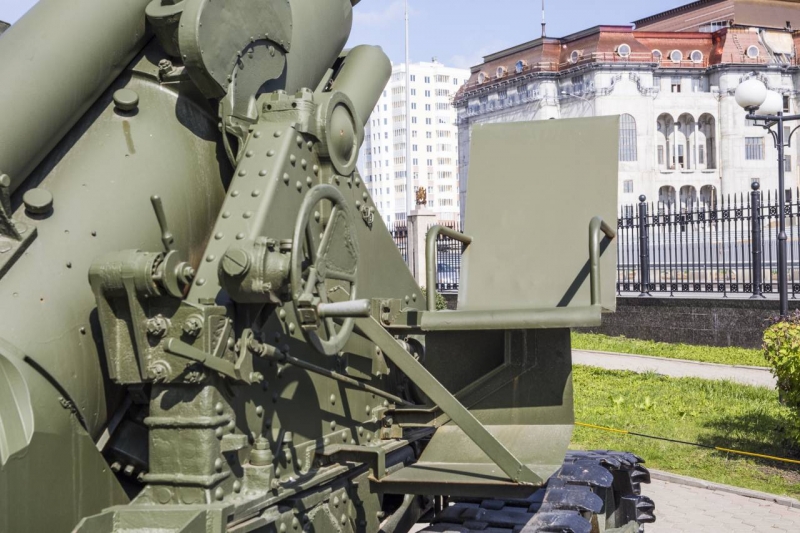
And one more episode. From the Battle of Berlin. B-4 participated in the street battles! Probably, most epic shots capture of Berlin taken with their participation. 38 guns on the streets of Berlin!
One of the guns was installed in 100 meters from the enemy at the intersection of Linden Strasse and Ritter-Straße. The infantry can not move forward. The Germans were prepared to defend the house. Guns could destroy the machine-gun nests and artillery positions. Our losses were large. We had to take risks. risk gunners.
Calculation of B-4, actually direct fire, 6-th shot destroyed house. Respectively, together with the garrison of Germans. Dovorachivaya gun, battery commander in passing destroyed three more prepared for the defense of the stone building. Thus providing an opportunity to promote the infantry.
by the way, interesting fact, which we once wrote. In Berlin, it found only one building, which has withstood the blows of the B-4. This is the famous tower defense in the zoo area Flakturm am Zoo. Our Howitzers were able to destroy the only corner tower. Garrison defended to virtually surrender ads.
After the war, the howitzer was removed from service. Alas, advantage crawler played a bad service in peacetime.
But this is not the end of history. Only an episode. The cannon once again adopted a! But now designers were tasked for its modernization. It was necessary to increase the transport speed guns.
AT 1954 , the plant «barricades» This upgrade was carried out. Howitzer B-4 was the wheel. Wheel stroke significantly increased towing speed guns, overall maneuverability, reduced transfer time from traveling to combat due to the elimination of the separate transport carriage and the barrel. Cannon received a new name-B-4M.
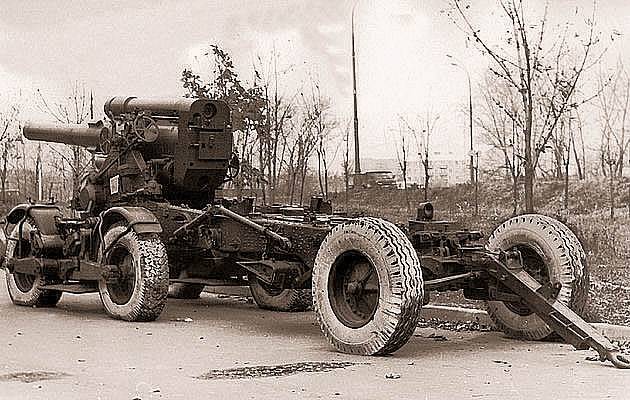
Series production of this gun was not conducted. Actually, carried out the modernization of the existing howitzer. The exact number of these guns we could not find.
But the fact, what in 1964 it was a nuclear weapon has been created for the B-4, It speaks volumes. Whatever it was, B-4 were in service until the early 80-ies. Almost half a century of service!
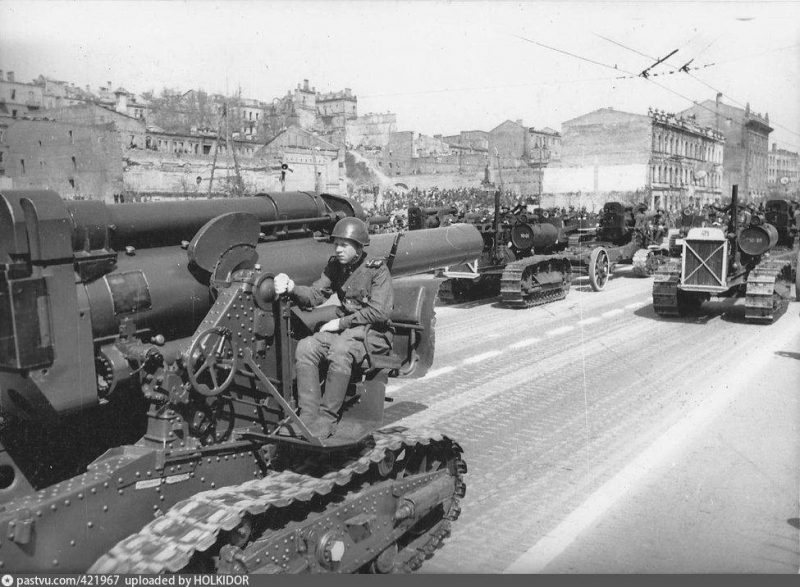
agree, an indicator value of tools. guns, which legitimately takes its place among the finest examples of artillery and engineering design ideas.







